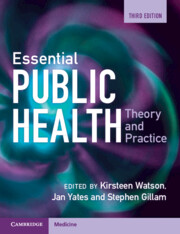Book contents
- Essential Public Health
- Essential Public Health
- Copyright page
- Contents
- Contributors
- Foreword
- Acknowledgements
- Introduction
- Part 1 The Public Health Toolkit
- Part 2 Contexts for Public Health Practice
- Introduction to Part 2: What Do We Mean by Contexts in Public Health?
- 11 The Health of Children and Young People
- 12 Adult Public Health and Non-Communicable Diseases
- 13 Public Health and Ageing
- 14 Health Inequalities and Public Health Practice
- 15 Health Policy
- 16 International Development and Public Health
- 17 Planetary Health
- Glossary
- Index
- References
16 - International Development and Public Health
from Part 2 - Contexts for Public Health Practice
Published online by Cambridge University Press: 01 December 2023
- Essential Public Health
- Essential Public Health
- Copyright page
- Contents
- Contributors
- Foreword
- Acknowledgements
- Introduction
- Part 1 The Public Health Toolkit
- Part 2 Contexts for Public Health Practice
- Introduction to Part 2: What Do We Mean by Contexts in Public Health?
- 11 The Health of Children and Young People
- 12 Adult Public Health and Non-Communicable Diseases
- 13 Public Health and Ageing
- 14 Health Inequalities and Public Health Practice
- 15 Health Policy
- 16 International Development and Public Health
- 17 Planetary Health
- Glossary
- Index
- References
Summary
This chapter extends the consideration of the changing global burden of diseases and discusses what is required to mount an effective response to public health challenges, particularly in countries where people are living in extreme poverty. It considers the role of international development assistance and the responsibilities of the international community in improving the health of poor people.
Keywords
- Type
- Chapter
- Information
- Essential Public HealthTheory and Practice, pp. 303 - 322Publisher: Cambridge University PressPrint publication year: 2023



